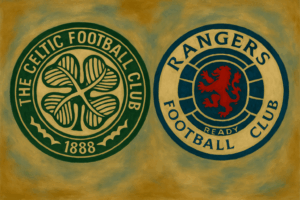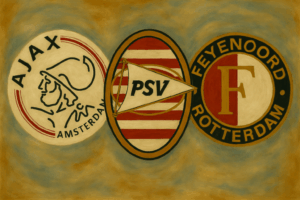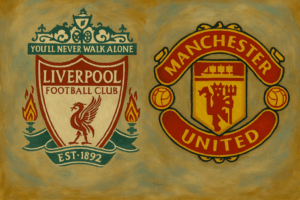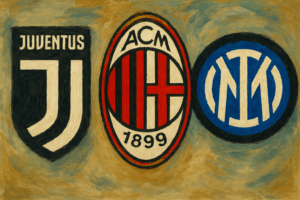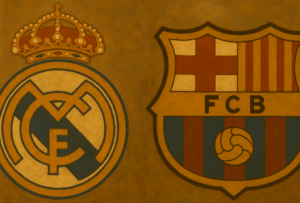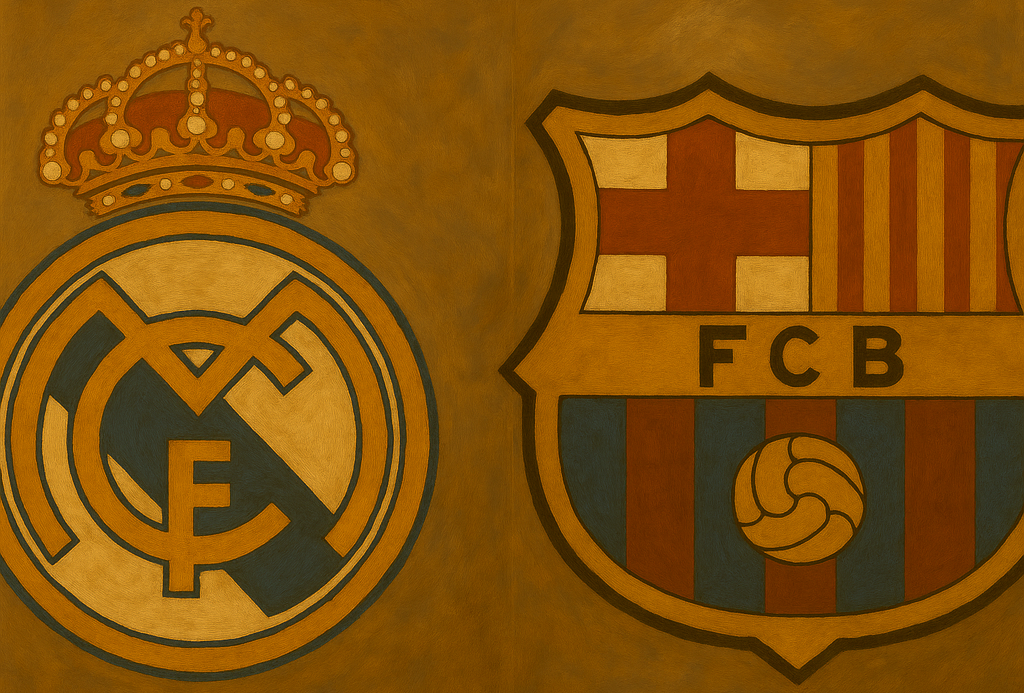
The GOAT of Spanish Football?
While many rivalries exist in the world of football, few command the global attention and symbolism of ‘El Clásico,’ the showdown between Real Madrid and FC Barcelona. This is more than just a football match featuring the world’s best players; it is a cultural phenomenon where two cities, two regions, and two opposing ideologies collide.
On one side stands Real Madrid, symbolizing the majesty of the Spanish central government and the royal family. On the other is FC Barcelona, representing the pride and identity of Catalonia. This article, moving beyond current squads or short-term tactical analysis as of 2025, will conduct an in-depth analysis of why Real Madrid and Barcelona are more than just football clubs by examining the fundamental pillars that support these two giants: their founding philosophies, the symbolism of their stadiums, and the legends who have graced their histories.
1. Philosophy and Culture: The Majesty of Royalty vs. The Heart of Catalonia
Real Madrid: The ‘Los Blancos’ Whose Identity is Victory
Real Madrid’s identity is synonymous with the word ‘victory.’ Their philosophy can be summarized as “winning at almost any cost.”
The Royal Mandate and the ‘Galácticos’ Philosophy
From the moment the club was granted the ‘Real’ (Royal) title by the Spanish king in 1920, its destiny was set. They project the club’s prestige and power on and off the pitch through the ‘Galácticos’ policy of signing the world’s most famous and expensive ‘superstars.’ This is an inevitable choice to maintain their identity as the best in the world.
The Nickname – ‘Los Vikingos’
The nickname ‘The Vikings’ was given to them by rival fans in the 1970s when they signed a large number of players from Northern Europe. Although initially a term of mockery, the fans embraced it as a symbol of power and conquest. This aligns with the club’s identity of establishing dominance by absorbing powerful external talent.
FC Barcelona: ‘More Than a Club’
FC Barcelona’s identity is entirely encapsulated in their famous motto, ‘Més que un club.’
‘Més que un club’ – The Deep Roots of the Motto
The phrase ‘More than a club’ originates from the Franco dictatorship era, when Camp Nou was one of the few sanctuaries where Catalans could freely express their identity. The club was not just a sports team but the heart of the Catalan community and a political and social focal point.
The La Masia Doctrine and Democratic Structure
Barcelona’s philosophy emphasizes internal development over external signings. The youth academy, ‘La Masia,’ is the cradle of Johan Cruyff’s ‘Total Football’ philosophy. Furthermore, the democratic structure, owned and operated by club members (‘socios’), institutionally supports the idea that the club belongs to the people.
2. The Hall of History: The Footprints of Two Giants Proven by Trophies
The philosophical clash of the two clubs is ultimately proven by the number of trophies on the pitch.
| Trophy | Real Madrid | FC Barcelona |
|---|---|---|
| La Liga | 36 | 28 |
| Copa del Rey | 20 | 32 |
| Supercopa de España | 13 | 15 |
| UEFA Champions League | 15 | 5 |
| FIFA Club World Cup | 9 | 3 |
| Total Major Trophies | 93 | 83 |
Real Madrid shows overwhelming dominance in La Liga and especially the UEFA Champions League, clearly demonstrating their identity as the ‘Kings of Europe.’ In contrast, Barcelona has won more domestic cups, proving their consistent strength within Spain.
3. Sanctuaries That Hold the Future: The Santiago Bernabéu and Spotify Camp Nou
The Santiago Bernabéu: The Temple of a 21st-Century Empire
As of 2025, the massively renovated Bernabéu has been elevated from a mere stadium to a state-of-the-art global entertainment hub. Its fully retractable roof and the ‘hypogeum’ system that stores the pitch underground allow it to host not only football but also concerts, NFL games, and various other events, maximizing revenue. This aligns with the Galácticos philosophy of aiming for the best in the world.
Spotify Camp Nou: A Rebirth Embodying the Soul of Catalonia
Camp Nou’s redevelopment project, ‘Espai Barça,’ aims to integrate the stadium as part of the city and community. The plan to increase capacity to 105,000 and develop the surrounding area into a multi-purpose cultural space is an architectural embodiment of the community-centric philosophy of being ‘more than a club.’
4. Timeless Icons: 10 Legends from Each Team
The Great Names of Real Madrid
- Alfredo Di Stéfano: The most important figure in Real Madrid’s history. The prototype of ‘Total Football’ who influenced every part of the pitch; under his leadership, the club wrote the immortal legend of five consecutive European Cup victories.
- Ferenc Puskás: ‘The Galloping Major.’ Led Real Madrid’s attack in the 1950s-60s alongside Di Stéfano with cannon-like shots from his left foot.
- Raúl González: ‘El Capitán.’ A product of the Real Madrid youth system who reigned as the team’s symbol for 16 years. Earned the absolute love of the fans with his natural goal-scoring instinct and limitless dedication.
- Zinedine Zidane: The artist of the first Galácticos era. His fantastic volley in the 2002 Champions League final remains one of the most iconic goals in club history. Also achieved unprecedented success as a manager.
- Iker Casillas: ‘Saint Iker.’ The greatest goalkeeper produced by La Fábrica. Dominated an era with phenomenal reflexes, consistency, and leadership.
- Sergio Ramos: The heart and fighting spirit of modern Real Madrid. Saved the team from crisis countless times with his strong defending and dramatic goals in clutch situations.
- Cristiano Ronaldo: The greatest goalscorer in club history. Left an unreal record of 451 goals in 438 matches and led another golden era, including three consecutive Champions League titles.
- Luka Modrić: The maestro of the midfield. A Ballon d’Or winner who dominated Real Madrid’s midfield with his tireless work rate and creative passing.
- Karim Benzema: The complete forward who evolved from a selfless provider to the team’s focal point. Proved his worth by winning the Ballon d’Or in 2022.
- Fernando Hierro: The great captain of the pre-Raúl era. The core of the defense, combining strong defensive ability, leadership, and excellent goal-scoring prowess.
The Heroes Who Graced FC Barcelona
- László Kubala: Barcelona’s first world-class superstar. His influence was so absolute that the club had to build Camp Nou to accommodate the fans who flocked to see him play.
- Johan Cruyff: Barcelona’s philosophical father. A revolutionary who introduced ‘Total Football’ as a player and laid the groundwork for the ‘Dream Team’ and ‘La Masia’ as a manager.
- Pep Guardiola: The man who inherited and perfected Cruyff’s philosophy. He was the linchpin of the ‘Dream Team’ as a player and, as a manager, created one of the greatest teams in history by maximizing ‘Tiki-Taka.’
- Hristo Stoichkov: The hot-headed ace of the ‘Dream Team.’ Won the Ballon d’Or in 1994 with his explosive personality and left-footed kicks.
- Carles Puyol: The eternal captain with the heart of a lion. A La Masia product who led the team’s defense with fighting spirit, dedication, and leadership.
- Xavi Hernández: The brain and heart of Tiki-Taka. The best midfielder produced by La Masia, he dominated the midfield with perfect passing and game control.
- Andrés Iniesta: The artist of the midfield. Formed the greatest midfield duo in history with Xavi and played a decisive role in crucial moments.
- Ronaldinho: The magician who brought the smile back to Barcelona. He joined a team in a dark period and changed the club’s atmosphere 180 degrees with his uniquely joyful and creative play.
- Sergio Busquets: The unsung hero. A revolutionary who redefined the defensive midfielder position. Without him, Tiki-Taka would have been impossible.
- Lionel Messi: The greatest player of all time. The greatest product of La Masia. He broke all the club’s records for most goals and appearances, and his very existence was Barcelona’s golden age.
Conclusion: A Never-Ending Story
The rivalry between Real Madrid and FC Barcelona transcends a simple football match.
Real Madrid was born with royal patronage, and its identity lies in ‘victory’ and ‘dominance.’ They prove they are the kings of European football through the ‘Galácticos’ policy of signing the world’s best players.
In contrast, FC Barcelona, under the motto ‘More than a club,’ is a symbol of resistance that has protected Catalan pride. They instill the club’s philosophy in their players through the unique youth system of La Masia.
The showdown between these two giants is a never-ending story. When one side conquers the world with a dazzling army of superstars, the other counters with tight-knit organization and philosophy. Their conflict poses a fundamental question about what a football club should be, and it is this fundamental difference that is the driving force that makes El Clásico the greatest and most fascinating rivalry in the world.
